This final podcast in the series combines the last three entries in the book. “I Wonder Why,” “Spider Webs-Geometry in Motion” and “These Beautiful Days” A quote from John Muir, describing the richness of outdoor experiences closes the podcast.
Waterfowl Return and Search for Food
June 6, 2017 7 am
Lovely, quiet morning. The air chilled, a slight breeze blowing. Scattered, puffy white clouds fill the sky.
I missed Fair Oaks Village and the chickens today. I rode my bike from home directly to the boat launch ramp. My morning melody is birds in trees chirping and twittering, combined with the distant buzz of motorcycles and humming cars crossing the Sunrise Blvd. bridge.
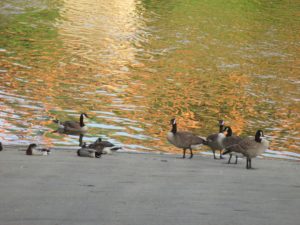 Canada geese and ducks are silent and still as they sit at the dry end of the boat ramp. Some ducks engaged in their morning clean up rituals. Sunrise is so early, the sun is well above the trees before I arrive. Pigeons wander the riverbank cooing and searching for nibbles. No people are here save a few boaters waiting on bites from shad.
Canada geese and ducks are silent and still as they sit at the dry end of the boat ramp. Some ducks engaged in their morning clean up rituals. Sunrise is so early, the sun is well above the trees before I arrive. Pigeons wander the riverbank cooing and searching for nibbles. No people are here save a few boaters waiting on bites from shad.
Minutes later the geese and ducks wander up the boat launch ramp looking for breakfast. They approach me waiting for handouts.
Rocky Remnants of a Fisherman’s Island
Friday, August 11, 2017 845 am 68 degrees
Six Canada Geese greet me with a chorus of characteristic honks as I arrive at Jim’s Bridge by bike.
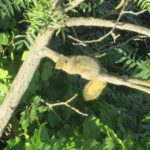
They join a dozen other ducks already scouting breakfast on the rocky shoreline. True to their nature the geese are late arrivals for the morning ritual. Squirrels are busy finding their breakfast in the trees.
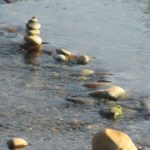
During a quick trip to the boat launch ramp, I see no waterfowl anywhere. No fishing boats sitting in the American River. Today I continue my ride east toward the Nimbus Fish Hatchery. This is the prime salmon spawning area come late September through early December. I used to see a dozen ducks bobbing in shallow rapids for food as I ride by. None today.
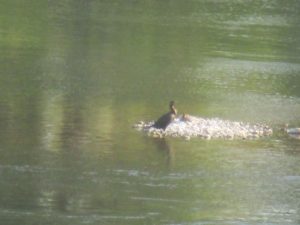
I arrive at the picnic area at the river’s edge, far off the bike trail, where last fall I saw 100 seagulls feasting on dead salmon. The small island located in the middle of the river channel that was big enough for fisherman to anchor their boats and stand alongside them in hip deep water is now two thin and barely visible stretches of rocks.
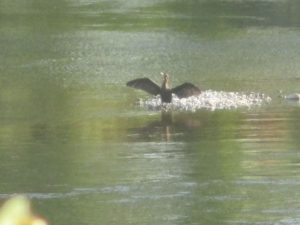 I spy a cormorant sitting on a rocky island hanging its wings to dry in the early morning air. It stands motionless for 10 minutes before flying away. I see ducks hide alongside green shrubbery of a nearby island jutting out from the western riverbank.
I spy a cormorant sitting on a rocky island hanging its wings to dry in the early morning air. It stands motionless for 10 minutes before flying away. I see ducks hide alongside green shrubbery of a nearby island jutting out from the western riverbank.
Except for an occasional distant quack from a lone duck, this area is quiet today. Here I am far away from homes hanging on the Fair Oaks Bluffs, traffic and people congregating on shorelines. I hear a distant hum from another roadway bridge alongside the fish hatchery, less than a mile and completely out of sight.
With no homes on the opposite shore, I see a mix of oaks, shrubs and grasslands. I could say they are in a natural and undisturbed state. Little along the river channel was left untouched during winter floods. Remnants are still visible everywhere along the river.
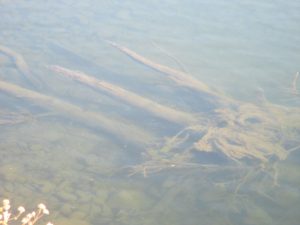
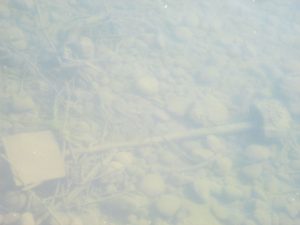
Reflections on Wildlife
Sunday September 10, 2017, 630 am 68 degrees
From my front porch, I watch the orange glow of sunrise above towering trees and behind scattered clouds.
 A tiny bird greeted me this morning, with ‘Ti Too.”
A tiny bird greeted me this morning, with ‘Ti Too.”
I ride to Jim’s Bridge hoping to see a crowd of Canada Geese and ducks engaged in morning rituals and scavenging for breakfast. They hang out on the south side of the riverbank first. Often women come to feed them seeds. When alone, they poke at the rocky shore and swim in shallow water, looking for worms, insects and other morning nibbles.
So few waterfowl are swimming near the Fair Oaks Bridge and nearby boat launch ramp. It is disappointing to visit the bridge and see only boaters. The river today is home to no life beyond that. I remember the Egrets that sat on the north riverbank each morning and the Great Blue Heron that came for an occasional visit. I remember the Egret flying farther east to avoid the Heron as it arrived. I think back to when the Canada Geese and the Mallards fight over food and fight among themselves. Geese hiss and bite. Mallards quack and complain, then chase away who they don’t like.
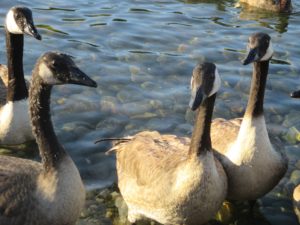 I arrive at Jim’s Bridge and all the waterfowl are here! The abandoned Pekin duck has joined the Mallard families. Quack! Quack! Quack! The ducks are quietly waking up, swimming, cleaning, quietly poking their head into the water searching for a morning meal. Occasionally one duck will rant, Quack! Quack! Quack! Quack! Quack! Quack! and no one pays attention. The geese and the ducks are expecting a morning handout.
I arrive at Jim’s Bridge and all the waterfowl are here! The abandoned Pekin duck has joined the Mallard families. Quack! Quack! Quack! The ducks are quietly waking up, swimming, cleaning, quietly poking their head into the water searching for a morning meal. Occasionally one duck will rant, Quack! Quack! Quack! Quack! Quack! Quack! and no one pays attention. The geese and the ducks are expecting a morning handout.
Mallards are so unlike chickens that call out to each other all day long, and call when no one is there to hear. When I hear ducks voice their opinions, no others respond.
In a moment, three ducks rise and fly quietly to the opposite shore. They are too far away and too fast to photograph. Watching them gives me a chance to take a big breath in, feel the chill on my skin. I look up in time to see 20 birds sitting on power lines above the Sunrise Blvd. bridge.
Temperatures are getting warmer already. I ride on to Fair Oaks Bridge. The parking lot for the boat launch ramp is filled with pickup trucks and utility vehicles equipped to tow their boats. I count seven boats in the river, all on the east side of the bridge. I see nearly as many fishermen on the American River as there are ducks.
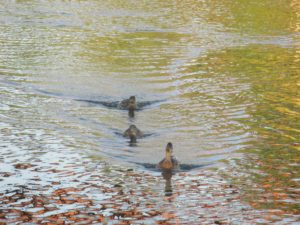 A mother duck leaders the way for her two young ducks. They casually swim by boats, leaning trees and those uprooted and fallen into the river. They pause their morning a few moments before moving on. So many birds twitter, unseen. So many times, I see feathers on the ground. I pick them up and wonder how did the birds or the chickens or even an owl lose their feathers? Was it a battle or an argument? Or was losing a feather a natural part of their growth? How do birds lose their feathers?
A mother duck leaders the way for her two young ducks. They casually swim by boats, leaning trees and those uprooted and fallen into the river. They pause their morning a few moments before moving on. So many birds twitter, unseen. So many times, I see feathers on the ground. I pick them up and wonder how did the birds or the chickens or even an owl lose their feathers? Was it a battle or an argument? Or was losing a feather a natural part of their growth? How do birds lose their feathers?
I believe that ducks, geese and birds exercise far more patience than people. People are often in a rush to get anywhere – pack in as much into the day as possible before dropping off to sleep or not even sleep. Waterfowl take their time to swim, to play, and to clean their feathers…and of course, finding food. A duck’s days are for sunning, sleeping, eating, relating to other ducks.
I sit here and wonder what is my role in helping to preserve this peaceful spot where wildlife can thrive?
If more of us sat down to wonder about the miracles of the natural world, would we enjoy more forward thinking environmental concerns and actions? Would more collaborative actions and few disagreements make a bigger difference? I am surprised at how many are just passing through, not noticing the scope of what is here. Envisioning a positive future is rarely a casual visitor’s first thought.
Moment to Moment Experiences
Saturday, October 28, 2017 720 am 52 degrees
When I arrive on the bridge, I see seven boats lined up on the American River (running from east to west). I find it curious the boats are always in a straight line on the eastern side of Fair Oaks Bridge. Boats always stay on the north side of the river. I am guessing the water level is deeper to support the boats. The south side where the boat launch ramp is located tends to be shallow almost half way out.
Two walkers pass. An older man calls out to me, “It is cheaper to buy salmon at the store than to go fishing in the cold. It is freezing out there on the water.” I turned and replied, “Then you miss the experience. You cannot buy the experience.”
I rarely have the opportunity to ask fishermen why they venture into the cold river before dawn to catch salmon. For devoted fishermen, catching a wild salmon, watching it jump and wriggle and try in vain to escape is the culmination of both joyful anticipation and planning. Some salmon get away. Their struggle to escape is stronger than the fishing line. At the final moment when the salmon is caught, skillful hands cannot hold on. The salmon wins the game to fight another day. Watching the sunrise, eating breakfast on portable grills on the boat are experiences no one can buy in a store.
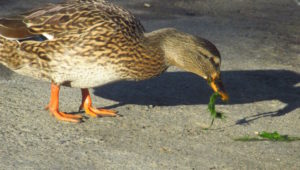
I watch the fishermen as they find the best spot, cast their lines and share fish stories between boats. I come outside to experience the chill in morning air, listen for a distant, yet unseen “quack, quack, quack,” and honks from Canada Geese, the graceful flight of seagulls and their calls to each other from the river.
Even after visiting this bridge more than 100 times, I continue to marvel at the beauty of this place.
Arriving at Fair Oaks Bridge, I always do a spider web check. This morning I marvel at two empty spider webs. These webs are meticulously attached to the Truss frame of the bridge. I watch the ripples in the water as ducks swim past me. Next I watch a circle of pigeons flying above the bridge. Canada Geese swim under the bridge. An egret flies and lands on the boat launch ramp. Ducks are busy finding breakfast on the boat launch ramp and under the water. I remain in awe how various species of birds take flight and land, using their wings and feet in different, yet very precise ways. Many waterfowl gather to feed on salmon. I don’t smell the scent of their decaying bodies as much as I have in the past. Two dead salmon lay at the river bottom below the bridge.
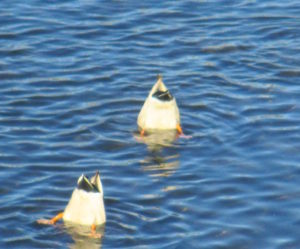
I stand and watch a series of circles in the water created by Canada Geese who rise and flap their wings in the air for 20 yards before ever lifting out of the water and rise into the sky. I listen to the sound of a tiny bird, “Ti Too. Ti too.” These birds return regularly to rest on the overhead truss of the bridge.
Lewis & Clark National Historical Park

Lewis and Clark National Historical Park – Chinook Middle Village Station in Astoria, Oregon.
This newly established site recognizes the Chinook people who lived along the mouth of the Columbia River for thousands of year. Artifact and inquiry-based lessons engage middle school students in a study of Chinook lifestyle and culture.
Did you know?
Chinooks used a river-based economy and used canoes as the primary mode of transportation. Carving a canoe from a single cedar tree could take up to a year. Large canoes were 50 feet long, held 20-30 people and could carry 8,000-10,000 pounds.
